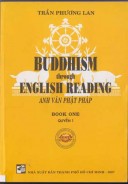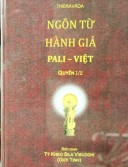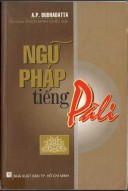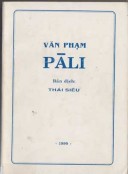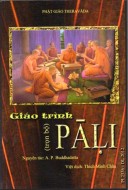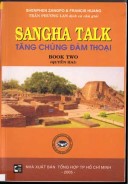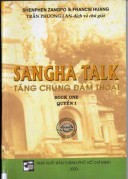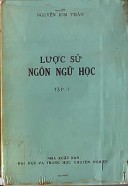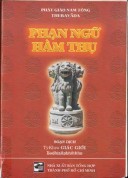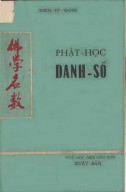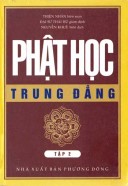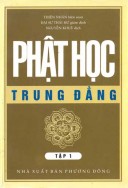Tìm Sách
Ngôn Ngữ >> Buddhism Through English Reading
Thông tin tra cứu
- Tên sách : Buddhism Through English Reading
- Tác giả : Trần Phương Lan
- Dịch giả :
- Ngôn ngữ : Anh - Việt
- Số trang : 376
- Nhà xuất bản : Thành Phố HCM
- Năm xuất bản : 2007
- Phân loại : Ngôn Ngữ
- MCB : 1201000008481
- OPAC :
- Tóm tắt :
BUDDHISM THROUGH ENGLISH READING
TRẦN PHƯƠNG LAN ANH VĂN PHẬT PHÁP
Bộ 3 quyển
BOOK ONE – Quyển I
Nhà xuất bản thành phố Hồ Chí Minh
2007
EDITOR’S INTRODUCTION
Dear Brothers and Sisters –in the Dhamma,
Dear Friends –in the-Dhamma,
This is book one of my teaching material for a complete course at the Vietnam Buddhist Academy, formely named the Vietnam Institute of Advanced Buddhist Studies in Ho Chi Minh City. The book containing 12 lessons, a number of supplementary readings and dialogues, and 3 conditional chapters is intended for the first year students. It may also serve as a self-study book for intermediate students of English who wish to learn Buddhist texts and a basic Buddhist technical vocabulary Through English reading.
This teaching material aims to provide Buddhist students with lessons on the Buddha’s fundamental teachings and at the same time it attemps to help them to develop their five language skills: listening, speaking, reading, writing and translating.
Since the students are led by gradual steps in learning the lessons, each lesson plan is arranged in 5 parts:
I. Pronounciation
II. Vocabulary
III. Comprehension Questions
IV. Translation into Vietnamese& into English
V. Grammar Review
I. Pronounciation: The first step in learning any lesson is to practise the pronounciation of the sounds and words introduced in each text. The grouping of words into sound columns helps you to practise reading aloud each sound, especially each pair of similar sounds (minimal pair) such as [i:], [I], ..[s], [z], etc…, each word and each column carefully and repeatedly before reading sentence by sentence, paragraph by paragraph several times.
II. Vocabulary: Technical vocabulary plays a very important part in learning Buddhist texts. But a large number of Buddhist technical words and expressions are entirely new to the intermediate students of English. They often find it hard to learn the terms partly because they are not accustomed to reading Englih book on Buddhism and partly because their common English vocabulary is poor.
1. The most important thing is that you need to know the basic and usual meaning of the words and expresions used in the text before coming to their figurative orcontextual meaning.
2. Synonyms, Antonyms and words og the same root (familly) including suffixes and prefixes are always helpful because they centre around the same subject.
3. While learning the vocabulary, you are show how technical terms are used in various examples given by your teacher. Follow those examples and buid sentences of your own, using the words and expressions you have learned carefully.
4. You are encouraged to memorise some sentences from each paragraph in the reading, particularly, some well-know quotations or the Dhammapada Verses, the Buddha’s basic teachings, which contain basic Buddhist technical terms.
III. Comprehension questions: Most of the questions can be answered directly from the reading. Practise asking the questions and making answer of your own after studiyng the text carefully. Have a classmate of yours answer a number of questions and then change the role. You can use the exact words and expressions of the text, but try to make your answer as simple as possible since many passages are written in formal or literary style, a style which is not common in spoken English. You can write your answer on the board and correct your mistakes with the help of some advanced students
IV. Translation:
1) Translation into Vietnamese: Once you have studied the text and the vocabulary carefully, you can translate each sentence and each paragraph easily with the help of chapter IV, which supplies you with lists of English – vietnamese equivalents
2) Translation into English: Every now and then , I Would like you to put into practice a number of words and expressions and sentence patterns that you have learnt from your lesson or grammar. Try to do the translation of your own carefully.
V. Grammar Review: Only a number of grammatical points concerning some sentence structures in the text are treated here because of time limitation in class.
While doing some revision of various kinds of clauses and sentences, the students learn how to make simple sentences , and then to combine them into compound and complex ones by using conjuntions and relative pronouns or adverbs. Besides, some forms and uses of the gerung, the infinitive, the participles, the reported speech, the formal or literary style are explained in brief.
VI. ChapterIII: This chapter consists of five supplementary lessons: some information about the VN Institute of Advanced Buddhist Studies (the form name of the VN Buddhist Academy in HCM City) and the VN Buddhist Risearch Institute, a number of dialogues that help you to talk about your school, your class, your monastic life and act out various roles at your English speaking club or at home when possible, a short introduction to Dhammapada, and lastly, an article by a modern Buddhist scholar, Professor Dhirasekera about the Buddhist concept of Beauty, which contains some verses from the Theragàthà (The Psalms of the Brethren), a book of the Original Pàli Canon. The Vietnamese metrical translation of the verses will somehow help you to practise translating English poems into Vietnamese ones
VII. Chapter IV, V, VI:
1) Chapter IVsupplies lists of English – Vietnamese Equivalents
2) Chapter Vgives answers to the questions based on the texts
3) Chapter VIgives the Vietnamese translation of the texts and the English translation of some sentences based on the lessons
ACKNOWLEDGEMENTS
- I am greatly indebted to the autors and translators listed in the bibliography for they invaluable references.
- I wish to express my deep gratitude to the Leadership of the VN Buddhist Academy in HCM City for their approval of this teaching plan and their support to my achievement.
- I would like to send my high appreciation to the Brothers and Sisters (of course III) who have assisted me in typing the manuscripts and correcting the proof with great care, especially Brother Thích Tâm Khanh, Sisters Thích Nữ Huệ Hương, Thích Nữ Diệu Thuận, Thích Nữ Nguyên Đoan and miss Trần Thì Kim Phượng.
- And I am also very grateful to many others who have contributed in various ways to the publication of the present book for the benefit of many people.
In spite of our point efforts , there many remain a number of weaknesses in this book. We sincerely hope to receive valuable suggestions from any professors and scholars who will kindly help us to improve our work for the next edition.
May the Triple Gem bless our meritorous deeds
May all of us be well and happy!
Yours –in the-Dhamma,
Upàdikà Nguyên Tâm TRẦN PHƯƠNG LAN
VN Buddhist Academy in HCM City
September 2000
CONTENTS
Editor’s Introduction
Bibligraphy
CHAPTER I: From the Buddha’s Birth to his Enlightement
- Lesson 1 : Religious Education and The Buddha’s Teaching
Grammar Revìew: The Simple present tense
- Lesson 2 : The Buddha’s Birth and his Chilhood
Grammar Review: The Simple Past. Sentences – Clauses
- Lesson 3 : Prince Siddhattha’s Youth & his married life
- Lesson 4 : Great Renunciation and Enleghtement-Nibbàna
Grammar Review: Adverb Clauses
CHAPTER II: From Buddha’s Enlightement to his Parinibbàna
- Lesson 5 : The Brahmà’s Appeal to the Buddha
Grammar Review: Relative Clauses
- Lesson 6 : The Turning of the Dhamma Wheel
Grammar Review: Relative Clauses
- Lesson 7 : The Teaching of the Dhamma: the Conversion of some famous Disciples
Part 1: The Conversion of the Three Brothers Kassapa
Part 2: The Discourse on fire
- Lesson 8 : The Conversion of the Two chief Disciples
- Lesson 9 : The Conversion of Angulimàla
Grammar Review: Relative Clauses
- Lesson 10 : Kàsi Bharadvàja Sutta
- Lesson 11 :
Part 1: The founding of the Sangha of Bhikkhunàs
Part 2: The Chief Disciples among the 4 Assemblies
Grammar Review: The Gerund – The Participles
- Lesson 12 : The Buddha’s Parinibàna
Grammar Review:
Reported Speech
Inversion of Subject and Verb
CHAPTER III: Supplementary Lessons
No 1. Introduction to the VN Buddhist Academy in HCM City
No 2. Introduction to the VN Buddhist research Institute
No 3. Welcome to the V. I.A. B. S. English – Speaking Club!
No 4. DHAMMAPADA
No 5. Buddhism and Beauty
CHAPTER IV: List of English – Vietnamese equivalents
Lesson 1
Lesson 2
-----------
Lesson 12
- Supplementary Lessons:
No 1
No 2
No 3
No 4
No 5
CHAPTER V: Answers
Lesson 1
Lesson 2
----------
Lesson 12
CHAPTER VI: Translations into Vietnamese & into English
Lesson 1
Lesson 2
----------
Lesson 12
- Suppementary lessons:
No 1
No 2
No 3
No 4
No 5
INDEX of technical terms
BUDDHISM THROUGH ENGLISH READING
Anh Vân Phật Pháp
Book two – Quyển 2
Nhà xuất bản thành phố Hồ Chí Minh – 2007
EDITOR’S INTRODUCTION
Dear Brothers and Sisters – in the-Dhamma,
Dear friends –in the-Dhamma,
This is book two of my teaching material for a complete course at the Vietnam Buddhist Studies in Ho Chi Minh City. The book containing six lesson, a number of supplementary readings and dialogues, is intended for the second-year students. It may also serve as a self-study book for intermediate students of English who wish to learn Buddhist text and a basic Buddhist terminology through English reading.
Most of selections are the English translation of the Discourses expounded by the Buddha himself and compiled in the Original Pàli Triple Canon (Tipitaka)
The book is divided into five chapters.
Chapter Iconsists of six lessons on the Buddha’s great Discourses and five lessons on English grammar.
- Lesson 13presents to the learner the Discourse on the Wonderful and Marvellous Qualities of the Buddha’s birth in detail from the time the Bodhisatta arose in the Tusita Heaven till the moment he appeared on Earth. In this lesson, the student learns the meaning of the term “Boudhisatta” and the Ten Perfections (Dasaparami) which each Bodhisatta practises in order to gain the supreme goal, Buddhahood, in his last birth.
The lesson is supplemented with a list of the Seven Buddhas.
- Lesson 14: Part I of this lesson deals with the Buddha’s answer to the Brahmin Dona’s question: “Who will your revence be?” and the beautiful Simile of the Lotus grown in the water and unsoiled by the water, symbolic of the Buddha in the world.
Part II in this lesson deals with the celebrated Smile of the mighty ocean with all its wonderful qualities representing the wonderful marvels of the Dhamma-Discipline.
In this lesson, the student learns the definition of the terms Asavà (Cankers), 37 Bodhipakkhiyà Dhammà (37 qualities contributing to Enlightenment), and 4 pairs of Persons making up 4 kinds of Holy Diciples.
- Lesson 15: in Part I, the wonderful simile of the Heavenly Coral Tree with all its divine power is used to illustrate the progressive power of the holy disciple from the time of his going forth until his enlightenment through the Four Jhànas and the full realisation of Nibbàna.
In part II, the unique qualities of a Tathàgata’s appearance in the world is fully explained by the Buddha, it is the appearance of a mighty light, a mighty radiance…and also mentioned are the unique qualities of the Venerable Sàriputta as the only person who perfectly keeps rolling the supreme Dhamma wheel.
This sesson supplies you with definition of the Tathàgata’s Ten Power and Four Confidences with which he claims the leader’s place in all assemblies.
- Lesson 16: Setting the Dhamma Wheel in motion, the First Discourse given by the Buddha to his First Five Disciples in the Deer Park presents the Four noble Truths and the noble Eightfold Path. The Buddha’s analysis of a being into five groups of grasping enables his disciples to understand the no-self characteristic expounded in his Second Discourse.
The lesson supplies you with the remarks on the discourse made by various Buddhist scholars.
- Lesson 17: The No-self doctrine is one of the Buddha’s fundamental teachings: Buddhism is unique in the history of human thought in denying the existence of a Soul/Self, It is thank to the discourse that the first five disciples attain Arahantship.
In this lesson, the Law of Cause and Effect is explained in briep and in full.
- Lesson 18: The discourse refers to the great power and majesty of the Tathàgata who comprehends the world and becomes all-conquering, omnipotent. In this discourse including a hymn, the definition of a “Tathàgata” is given with various figures of speech by the Buddha himself.
The lesson is supplied with the meaning of Eight Vimokkha (Deliverances)
In addition, the Grammar Review is supplied at the end of some lessons to help the learner to understand a number of grammatical structures used in the texts.
Chapter II: Five supplementary lessons
- Lesson 1: Yuvanjana Jàtaka ie a moving story of the Buddha’s former Births compiled in the Khuddaka Nikàya. It deals with the Mastre’s Great Renunciation in the old days as well as nowadays.
- Lesson 2: Canda-Kinnara Jàtaka is a wonderful story which the Mastre told about the noble qualities of Ràhula’s mother when he returned to Kappilavatthu to see his family. The Vietnamese metrical translation of the verses will somehow help you to practise rendering English poems into Vietnamese ones.
- Lesson 3: supplies you with a dialogue between VBA (VIABS) graduate student and some visitors about Thiên Mụ, the most famous ancient pagoda in Huế, our ancient capital, and a detailed description of the pagoda and its stupas.
_ lesson 4: supplies you with a dialogue between a resident in Vĩnh Nghiêm padoda and some Japanese visitors about the most famous pagoda and its stupas.
- Lesson 5: supplies you with a briep survey of Vietnamese Buddhist history from its very beginning in ancient time to the 10th century, its Decline and its Restoration in later centuries and its Activities in the Present Sutuation.
Chapter III: supplies lists of English-Vietnamese Equivalents.
Chapter IV: gives answer to the questions based on the texts
Chapter V: gives Vietnamese and English translations
ACKNOWLEDGEMENTS
- I am grestly indebted to the authors and translators listed in the Bibliography for their invaluable references.
- I wish to express my deep grititude to the Leadership of the VN Buddhist Academy in HCM City for their approval of this teaching plan and their support to my achievement.
- I would like to send my high appreciation to the Brothers and Sisters (of Course III) who have assisted me in typing the manuscripts and correcting the proof with great care, especially Brother Thích Tâm Khanh, Thích Quang Thạnh, Sisters Thích nữ Huệ Hướng, Thích nữ Diệu Thuận, Mr. Nguyễn Hữu Trọng and Miss Trần Kim Phượng.
- And I am also very grateful to many others who have contributed in various ways to the publication of the present book for the benefit of many people.
In spite of our joint efforts, there many remain a number of weaknesses in this book. We sincerely hope to receive valuable suggestions from any professors and sholars who will kindly help us to improve our work for the next edition.
May the Triple Gem bless our meritorious deeds
May all of us be well and happy!
Yours-in-the-Dhamma
Upàsikà Nguyên Tâm TRẦN PHƯƠNG LAN
VN Buddhist Academy in HCM city
May 2002
CONTENTS
Editor’s Introduction
Bibliography
CHAPTER I: THE BUDDHA’S GREAT DISCOURSES
Lesson 13: Discourse On the Wonderful and Marvellous qualities
Lesson 14:
Part I: The Buddha in the World
Part II: The Wonderful Marvels of the Dhamma –Vinaya
Lesson 15:
Part I: The Kovilàra Pàricchattaka tree
Part II: The One person
Lesson 16: The First Discourse of the Buddha: Setting in motion wheel of truth
Lesson 17: Discourse on the No-self characteristic
Lesson 18: A Tathàgata in the world
CHAPTER II: SUPPLEMENTARY LESSONS
Lesson no 1:
Yuvanjana Jàtaka (No 460)
Canda –Kinnara (No 485)
Lesson no 3: Welcome to Thiên Mụ pagoda!
Lesson no 4: Welcome to Vĩnh Nghiêm pagoda!
Lesson no 5: A brief history of Vietnamese Buddhism
CHAPTER III: LISTS OF ENGLISH-VIETNAMESE EQUIVALENTS
(Bản từ ngữ Anh Việt tương đương)
Lesson 13: Discourse on the Wonderful and Marvellous qualities
Lesson 14: The Buddha in the world
Lesson 15:
Part 1: The Kovilàra Paricchattaka tree
Part 2: the one person
Lesson 16:
Dhamma – Cakkappavattana Sutta
Summary of the Remark on Dhamma – Cakkappavattana Sutta
The No-self characteristic
Summary of the remarks on the No-self characteristic
Lesson 18: A Tathàgata in the world
Bài đọc 1: Yuvanjàna
Bài đọc 2: Canda – Kinnara
Bài đọc 3: Welcome to Thiên Mụ pagoda!
Bài đọc 4: Welcome to Vĩnh Nghiêm pagoda
Bài đọc 5: A brief history of Vietnamese Buddhism
CHAPTER IV: ANSWERS
Answers : (lesson 13)
Discourse on the wonderful and Mavellous qualities
Answers : (lesson 14)
The Buddha in the world
Answers : (lesson 15)
The Kovilàva Pàricchattaka tree
The one person
Answers : (lesson 16)
Setting in motion the wheel of truth
Answers : (lesson 17)
Discourse on the No-self characteristic
Answers : (lesson 18)
The Tathàgata in the world
CHAPTER V: TRANSLATION INTO VIETNAMESE & ENGLISH
(Các bản dịch Anh Việt & Việt Anh)
Bài 13:
A- Bản dịch Việt Văn
B- Bản dịch Anh Văn
Bài 14:
A- Bản dịch Việt Văn
B- Bản dịch Anh Văn
Bài 15:
A- Bản dịch Việt Văn
B- Bản dịch Anh Văn
Bài 16:
A- Bản dịch Việt Văn
B- Bản dịch Anh Văn
Bài 17:
A- Bản dịch Việt Văn
B- Bản dịch Anh Văn
Bài 18:
A- Bản dịch Việt Văn
B- Bản dịch Anh Văn
Bài đọc 1: Tiền thân Đức Phật
Bài đọc 2: Tiền thân Đức Phật
Bài đọc 3:
Hoan nghênh/ Chào mừng các bạn đến chùa Thiên Mụ!
Bài đọc 4:
Chào mừng các bạn đến chùa Vĩnh Nghiêm!
Bài đọc 5: Lược sử Phật giáo Việt Nam
INDEX TECHNICAL TERMS
TRẦN PHƯƠNG LAN
BUDDHISM THROUGH ENGLISH READING
ANH VĂN PHẬT PHÁP
Book three – Quyển 3
Nhà xuất bản thành phố Hồ Chí Minh – 2007
EDITOR’S INTRODUCTION
Dear Brothers and Sisters –in-the-Dhamma,
Dear friends –in-the-Dhamma
This is book III, the last one in my Buddhism Through English reading (BTER) series. The book containing six lessons, a number of supplementary readings and speeches, is intended for the last two-year students at the Vietnam Buddhist Academy (VBA) in Ho Chi Minh city. It may also serve as a self-study book for post-intermediate and advanced students of English who wish to learn Buddhist text and a basic Buddhist terminology through English reading.
All the selections are the English translations of the Discourses expounded by the Buddha himsesf and compiled in the Original Triple Canon (Tipitaka)
The book is divided into five chapters
Chapter I: consists of six lessons on the Buddhist discourses and some grammar notes: lesson 19 ->lesson 24
- Lesson 19: “The Kàlàmas at Kesputta” is the famous discourse dealing with the Buddha’s advice to the Kàlàmas on how to find out truth and falsehood. It also reveals the freedom of thought allowed by the Buddha to his disciples on the way seeking for truth.
The lesson is supplied with the remarks on the discourse made by famous Buddhist scholars and the 14 steps leading to truth explained by the Buddha in the Kìtagiri Sutta.
- Lesson 20: The Discourse to Màlunkyàputta deals with the Ten Questions by the Buddha, the reason why he didn’t explain them and the well-known simile of a wounded man used to describe a disciple who wishes to get the answer to those questions from the Tathàgata.
- Lesson 21: The discourses presents how the Elder Sister Khemà, one of the Buddha’s two chief female disciples, wisely answeredKing Pasenadi’s question about the Tathàgata’s existence or non-existence after death and the King’s great amazement at the Wonderful harmony between the Master’s and his disciple’s words
- Lesson 22:The Discourses refers to the method of controlling all cankers and the Seven ways of Riddance: vision, control, use, endurance,avoidance,elimination and cultivation. The discourse show the striking contrast between the practical method used by a holy man of wise attention and the speculative views produced by unwise eternalists or annihilationists of all time.
- Lesson 23: Excepts from Mahà-Parinibbàna Sutta
Part Ideals with the Elder Ànanda’s request to the Lord to give the last instructions concerning the Sangha and the Lord’s answer to this question.
Part IIdeals with Màra’s request to the Lord to pass away and his reply to this question.
Part IIIdeals with the Lord’s explaination on how he should be rightly honoured and held sacred by his disciples after his passing away.
The lesson is supplied with a detailed summary of the Mahà-Parinibbanà Sutta in the Digha-Nikàya II
- Lesson 24: The Foundation ofMindfulness is the only way for the Purification of beings…for the destruction of suffering, for realising Nibbàna.
In this discourse, the Buddha gives the exposition of the four bases of mindfulness in full and its fruition in this very life.
The lesson is supplied with explanatory notes extracted from the famous commentary “The way of Mindfulness” by Soma Thera.
Chaptre II: Five supplementary lessons
- Lesson 1: Kanthaka’s Mansion: a story taken from Khuddaka Nikàya (the minoir Anthology of the Pali Canon) about Kanthaka, Prince Siddattha’s horse, who becomes a deva (god) in the Thirty-Tree Heaven after carrying the Prince away on the night of his great Renunciation.
- Lesson 2: Rajjumàlà’s Mansion: also a story from Khuddaka Nikàya about Rajjumàlà, a Buddhist female lay-follower, who becomes a devì (goddess) in he Thirty-Three Heaven after leading a life of good faith in the Triple Gem on earth.
- Lesson 3: An Ode to the Buddha’s Birth: an except from the Light of Asia by Sir Edwin Arnold, an English poet and scholar in the 19th century.
- Lesson 4: Buddhism, Ecology andBuddhist Ethics: a speech by the Most Venerable Dr. Thích Chơn Thiện, Vice Rector of the VN Buddhist Research Institute and Dr. Ngô Bá Thành at the World Peace Council Conference in Hanoi on March, 24, 1999.
- Lesson 5: Suffering si closed where Love is open: a speech by the Most Venerable Dr. Thích minh Châu, Heat of ABCP VN National Centre at the X ABCP Conference in Laos on Feb, 27, 2003.
Chapter III:supplies lists of English-Vietnamese Equivalents
Chapter IV: gives answers to the questions based on the texts
Chapter V:gives Vietnamese and English translations
With the careful step-by-step method and right effort, I believe you make much better progress in studying the Buddha’s discourses and Buddhist technical terms from now on.
ACKNOWLEDGEMENTS
- I am greatly indebted to the authors and translators listed in the bibliography for their invaluable references
- I wish to express my deep gratitude to the Leadership of the VN Buddhist Academy in HCM city for their approval of this teaching plan and their support to my achievement.
- I would like to send my high apprecition to the Brothers and Sisters (of Course III) who have assisted me in typing the manuscripts and correcting the proof with great care, especially Brother Thích Thâm Khanh, Thích Quang Thạnh, Sisters Thích nữ Huệ Hướng, Thích nữ Diệu Thuận, Mr. Nguyễn Hữu Trọng and Miss Trần Kim Hiền.
-And I am also very grateful to Mr. Trần Đình Việt, Director of the Publishing house in HCM city, and many others who have contributed in various ways to the publication of the BTER series for the benefit of many people.
In spite of our joint efforts, there many remain a number of weaknesses in this book. We sincerely hope to receive valuable suggestions from any professors and scholars who will kindly help us to improve our work for the next edition.
May the Triple Gem bless our meritorious deeds.
May all of us be well and happy!
Yours-in-the-Dhamma
Upàsikà Nguyên Tâm TRẦN PHƯƠNG LAN
VN Buddhist Academy in HCM city
May 2003
CONTENTS
Editor’s introduction
Bibligraphy
CHAPTER I: THE BUDDHA’S GREAT DISCOURSES
Lesson 19: The Kàlàmas of Kesaputta (Abridged)
Lesson 20: Lesse discourse to Màlunkyà (Putta)
Lesson 21: the Elder Sister Khemà (Abridged)
Lesson 22: Discourse on all the Cankers (Sabbàsavasutta) (Abridged)
Lesson 23: Excepts from Mahà Parinibbàna Sutta (the book of the great decease)
Lesson 24: Discourse on the foundation of mindfulness (Satipatthànasutta) (Abridge)
CHAPTER II: SUPPLEMENTARY LESSONS
Lesson No 1: Kanthaka’s Mansion (Kanthakavimàna)
Lesson No 2: Ràjjumàlà’s Mansion (Rajjumàlàvimàna)
Lesson No 3: An ode to the Buddha’s birth
Lesson No 4: Buddhism, Ecology and global ethics
Lesson No 5: Suffering is closed where love is open
CHAPTER III: LISTS OF ENGLISH-VIETNAMESE EQUIVALENTS
(Bản từ ngữ Anh Việt tương đương)
Lesson 19: The Kàlàmas of Kesaputta
Lesson 20: Màlunkyaputta Sutta
Lesson 21: The elder sister Khemà
Lesson 22: All Cankers
Lesson 23: ---------
A- Excepts from Màha Parinbbàna Suttanta
B- Summary of the Màhaparinibbàna Sutta
Lesson 24: The foundation of mindfulness
Bài đọc thêm số 1: Kantha’s mansion
Bài đọc thêm số 2: Rajjumàlà’s mansion
Bài đọc thêm số 3: An ode to the Buddha’s birth
Bài đọc thêm số 4: Buddhism, Ecology and global ethics
Bài đọc thêm số 5: Suffering is closed where love is open
CHAPTER IV: ANSWERS
Answers: (lesson 19) – The Kàlàmas at Kesaputta
Answers: (lesson 20) – Discourse to Màlunkiyàputta
Answers : (lesson 21) – The elder sister Khemà
Answers : (lesson 22) – Discourse on all Cankers
Answers : (lesson 23) – Mahà Parinibbàna
Answers : (lesson 24) – Discourse on the foundation of mindfulness
CHAPTER V: TRANSLATIONS INTO VIETNAMESE & ENGLISH
(Các bản dịch Anh Việt & Việt Anh)
Lời giới thiệu của soạn giả
Bài 19:
A- Bản dịch Việt Văn: các vị Kàlàmas ở Kesaputta
B- Bản dịch Anh văn
Bài 20:
A- Bản dịch Việt Văn: Tiểu kinh Màlunkyàputta
B- Bả dịch Anh văn
Bài 21:
A- Bản dịch Việt văn: Trưởng lão Ni Khemà
B- Bản dịch Anh văn
Bài 22:
A- Bản dịch Việt văn: Kinh Tất cả Lậu Hoặc
B- Bản dịch Anh văn
Bài 23:
A- Bản dịch Việt văn: Trích đoạn kinh Đại Bát Niết Bàn
B- Bản dịch Anh văn
Bài 24:
A- Bản dịch Việt văn: Kinh Niệm xứ
B- Bản dịch Anh văn
Bài đọc thêm số 1: Lâu đài của Kanthaka (Ngựa Kiền Trắc)
Bài đọc thêm số 2: Lâu đài của Rajjumàlà
Bài đọc thêm số 3: Đạo ca Xưng Tán Đức Phật Đản Sinh
Bài đọc thêm số 4: Phật giáo – Sinh Thái học và Đạo Đức toàn cầu
Bài đọc thêm số 5: Lòng Từ mở ra, khổ đau khép lại
INDEX OF TECHNICAL TERMS
 Facebook
Facebook
 Google
Google
 Google+
Google+
